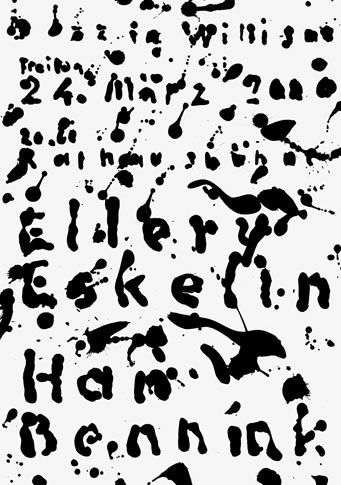samiland is my land
A selection of Niklaus Troxler's posters for the Willisau Festival.
+
A yoik is not a song but a resonant melodic phrase, sung unaccompanied and repeated through various iterations with no fixed beginning or end. Traditionally utilised to induce a trance state in Sami shamans, it is a music essentially animist in nature. Yoiks are not sung about something but considered a rhythmic signifier of the actual thing itself, be it a place, an event, a family member, associate or an animal, especially reindeer. According to Sami practice, a yoik is not composed but received through adjagas. After a yoik is first invoked, it shimmers into eternity, hanging in the air like a memory, waiting to be recalled.The parallels with Eric Dolphy's famous quote and the "stream-of-conciousness" of Olu Dara and Phillip Wilson (see below) are striking.
(...)
Ande Somby begins to yoik, merrily repeating a chain of syllables. 'ME GO NA CHA ... ME GO NA CHA.' Round and round it goes, faster and faster, like a tongue twister. Then the chain abruptly changes. 'DA CLIN KEE ... DA CLIN KEE ... DA CLIN KEE.'
- Arctic Magic
+
Ethan Iverson had set the bar vey high for D:O guest posts, and Taylor Ho Bynum has upped it further with his contribution. Taylor had already discussed some of these issues (cornet vs. trumpet, etc.) on his blog, but here they're laid out more clearly.
+
A few hundred (thousand?) birds will always beat industrial forms of light and magic. [via stop the play and watch the audience]
+
David Murray's MySpace page is dedicated to his Black Saint catalogue. The blog has him reminiscing about those albums. Of Murray's Steps, he says:
The four compositions on this date represent the best of what my octet had achieved on a recent tour. Getting from Nickelsdorf to Milano by train was very difficult though as Steve was thrown in jail off of the train for slugging a customs officer in the face. When this happened my leader abilities were seriously challenged so I told all of the band and their girlfriends to get off of the train. We went to the railroad border police station sat in front of the police, leading [sic] with them to let Steve McCall go. Finally we succeeded and were able to cross the border into Italy and go to Milano to make this recording session.
+
John Fordham reprised Nate Chinen's story about the 1973-1990/Behearer phenomenon for the Guardian's blog back in December. I found the article via Net, Blogs and Rock'n'Roll, which sums up the process and describes it as "uncharacteristically neat."
Back in June, Fordham prefaced a state of UK jazz address with this odd comment: "Jazz musicians and fans rarely ask where jazz is going." Really? He also got a classic Iverson quote, on being dropped from Sony, despite good sales (in jazz terms): "Whatever the Bad Plus have sold, I'm sure it didn't pay for coffee in that huge building Sony has on 56th and Madison."
+
The much-blogged IAJE gets a stern talking-to from Paul de Barros and runs to George Varga's arms for a pick-me-up cuddle. [via Arts Journal]
de Barros says that "while the [jazz] scene may be vivid and exciting, it's an artificial construct, sadly untethered to any specific time and place or anything actually going on in American society." That assessment is undermined by saxophonist Chelsea Baratz when she says "It's not one niche now, [there are places in New York where, on the same night, you can hear] unbelievably groovin' hip-hop, played by jazz musicians, [more cerebral music and] straight-up bebop."
de Barros is "sad" to hear "a genius like Ornette Coleman... so stuck in the racial paradigms of the past." Coleman, interviewed by Greg Osby, and "seemingly annoyed that IAJE was largely patronized by white academics," asked "If we were white people, would this conversation be the same?" Out of context, it's hard to judge such a statement, but the answer seems too obvious to be controversial. Varga is saddened by the very opposite: "Significantly, [James] Moody was the only speaker whose salute to [Ella] Fitzgerald also touched on the segregation and rampant racism of the era in which he and she achieved stardom." The theme continues, as in de Barros's article jazz is said to have "fallen into the hands of a lot of white males" and become "like a museum." de Barros agrees, but the relationship between white-ification and museumification is unclear, as "jazz postage stamps and the Jazz at Lincoln Center colossus" are cited amongst the reasons for jazz having "shed its outlaw skin." (implying that Duke Ellington and the MJQ, for example, might have considered themselves outlaws...). More (much, much more - be afraid) on this topic to come soon.
In Varga's article Ramsey Lewis's takes everyone to task:
"Jazz people are passive people," he charged. "They don't spread the word. We don't go to non-jazz people, and say 'Have you heard this?'"I guess he'd disagree with Bill Shoemaker's assessment that
you can’t cross market jazz out of its niche market condition, nor can you grow an audience significantly beyond its current numbers. The task, then, whether you’re a label, venue or festival, is to maximize participation of the existing audience
+
Top 50 Worldwide album sales in 2006

|